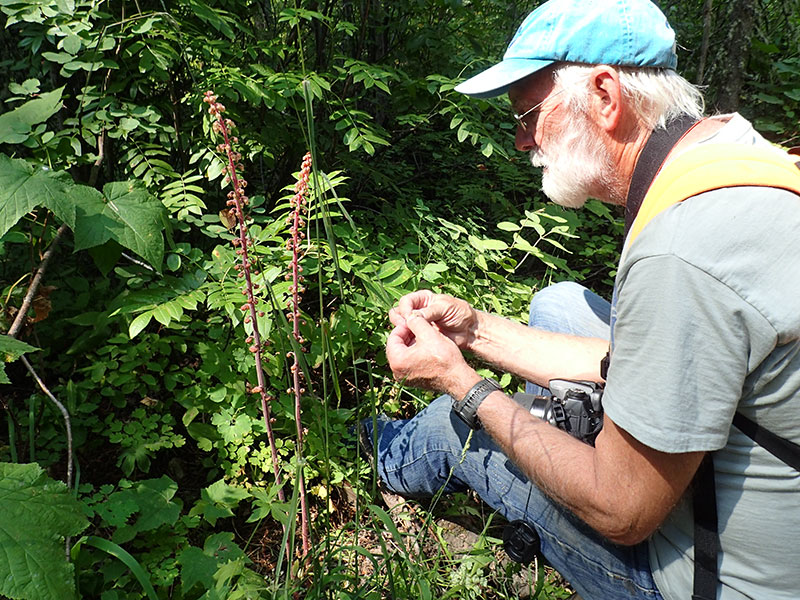Pterospora andromedea / woodland pinedrops
- sticky-haired, reddish brown plant; no chlorophyll
- nodding, yellow and pink flowers like upside-down urns
- unbranched stem with “invisible” scale-like leaves at base
- old, woody stalks with pumpkin-shaped capsules persist at least one season
- in pine or mixed conifer forests
Also known as: pinedrops, Albany beechdrops, giant bird’s nest, giant pinedrops
For other myco-heterotrophs, see also: Corallorhiza maculata / spotted coralroot; Corallorhiza striata / striped coralroot; Chimaphila umbellata / pipsissewa
Biologically, pinedrops is (and are) one of the more interesting species in the Valley. Starting with the simple stuff… pinedrops is the only member of the genus, Pterospora. The aboveground plant is tall, up to 3 feet or more, and totally without chlorophyll. Instead, all you see is the reddish-purple, unbranched and quite sticky flowering stalk. You will find them in the moist understory of a coniferous forest. Supposedly, the stems are edible raw or cooked. Ask your mother first.
Pinedrops are often confused with orchids, especially coralroots (Corallorhiza spp.), which also lack chlorophyll, but pinedrops have “regular” flowers. The flowers themselves are small, white and pink, urn-shaped, and pendent, i.e. hanging upside-down. They are arranged on a long raceme or spike. Each flower has 5 short, red-ish sepals and a rounded corolla that opens to five curved lobes. The flowers open from the bottom of the spike to the top. It is unclear whether the flowers are selfing or if there is an insect pollinator.
Each pinedrops stalk only flowers once, i.e. it is monocarpic/semelparous. Following flowering, in mid to late summer, the stems become quite woody and stiff with pumpkin-shaped seed capsules. They may persist like that for a few years. The seeds are short-lived and incredibly tiny. If you pull apart a “pumpkin”, the very small things you see are not the seeds themselves but the wings attached to the seeds. The wings are about 5-times the width of the seeds.
Technically, there are leaves, but they are small and scale-like and mostly limited to the lower stem. Like the stem, they are purple-ish. They are quite easily overlooked.
Pinedrops typically occurs in small populations and although it is perennial, not all plants appear aboveground every year. Individual plants exist for most of their life as a mass of brittle but fleshy roots. The roots are highly branched and all intertwining to form a compact mass about 3 inches in diameter.
Interesting bits – Just as the bulk of a pinedrops is below ground, that is also where the most interesting bits of its life cycle happen. Like several other species on this site (check the “see also” section above), pinedrops is an obligate parasite and a “myco-heterotroph”. This means it depends on an association with a mycorrhizal fungus for its nutrients and carbon. The fungus, in turn, depends on an association with a coniferous tree, usually a pine, for its carbon.
As is typical for mycorrhizae, the fungus is specific to a host tree species, and pinedrops, in turn, is specific to the fungus. Thus, pinedrops are also limited to the single tree species. In the western US, the fungus is Rhizopogon salebrosus. This is a basidiomycete (mushroom forming fungus) known as “false-truffle” or “root balls”. Although you might think that the trees would be better off without all these freeloaders, this isn’t the case. The mycorrhizal association is essential to the ecology of the forest and the trees grow very poorly, if at all, without it. This is largely due to the fact that the fungus supplies the tree with phosphorous and nitrogen, and the mass of mycelia (thin fungal “body cells”) below ground greatly extends the water absorbing capacity of the tree.
Pinedrops derive all the benefits of this symbiosis by using the nutrients from the fungus and the carbohydrates that are transferred from the trees. This also has a payoff for the fungus… exudates from the “parasite” appear to stimulate the growth of both the fungus and its associated trees.
To keep up the weirdness, despite the “parasitic” nature of the relationship of pinedrops to the fungus, it is the fungi that first colonize the seeds and then the pinedrops roots, forming a substantial mycorrhizal sheath over them and even penetrating the root cells themselves (this is unusual for ectomycorrhizae). An enzyme secreted by the fungus living on the seeds is essential for their germination, so this is hardly “by chance”.
It appears that P. andromedea often becomes established when its host tree is young and its roots are near the soil surface. In some cases, pinedrops have been seen in profusion on slopes. This all suggests that aeration is important to all aspects of the symbioses.
For more on this association and the life history of pinedrops, try looking here or here.
| Color | |
|---|---|
| Family | |
| Blossom size | |
| Inflorescence size | |
| Inflorescence type | |
| When? | |
| Where? |



